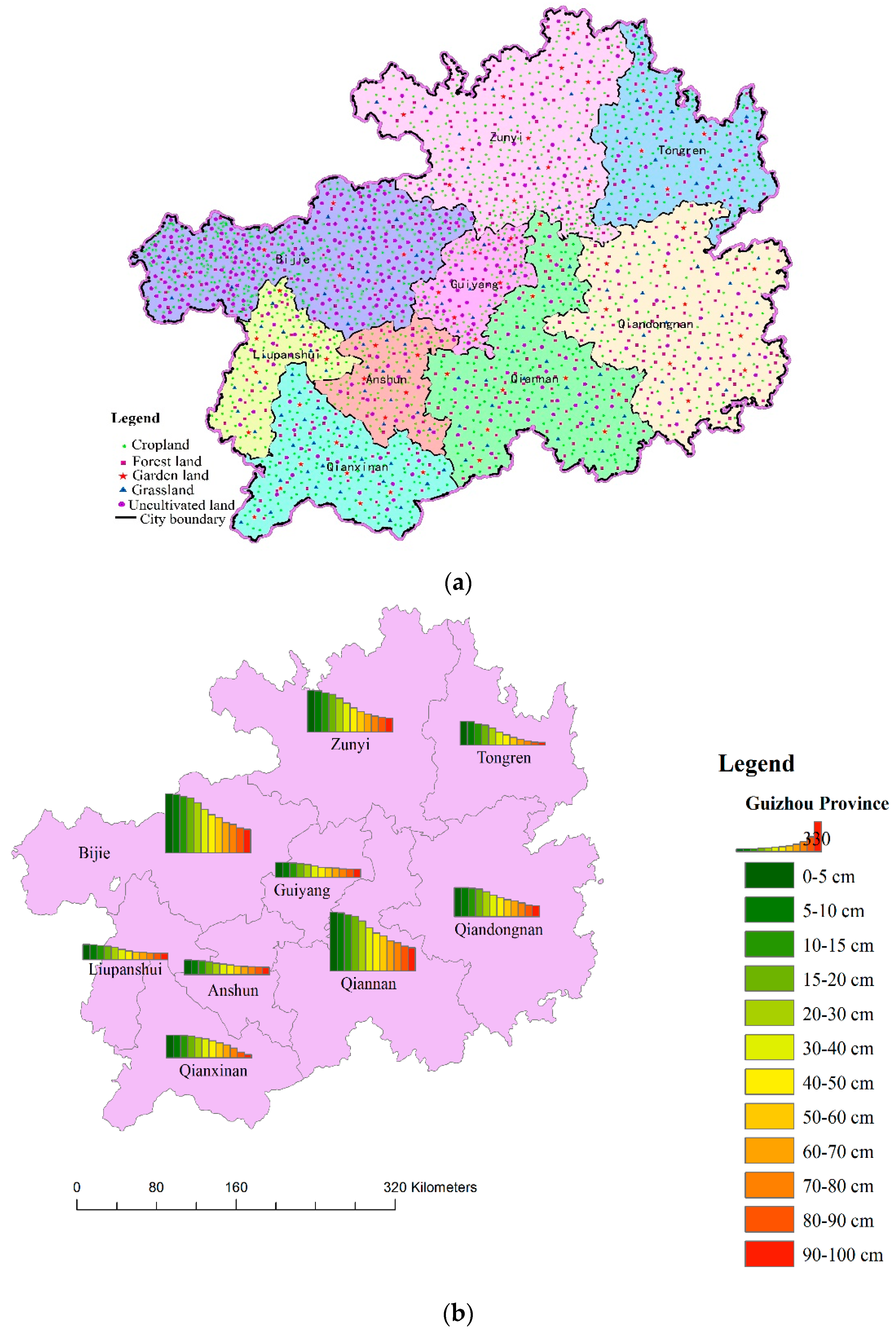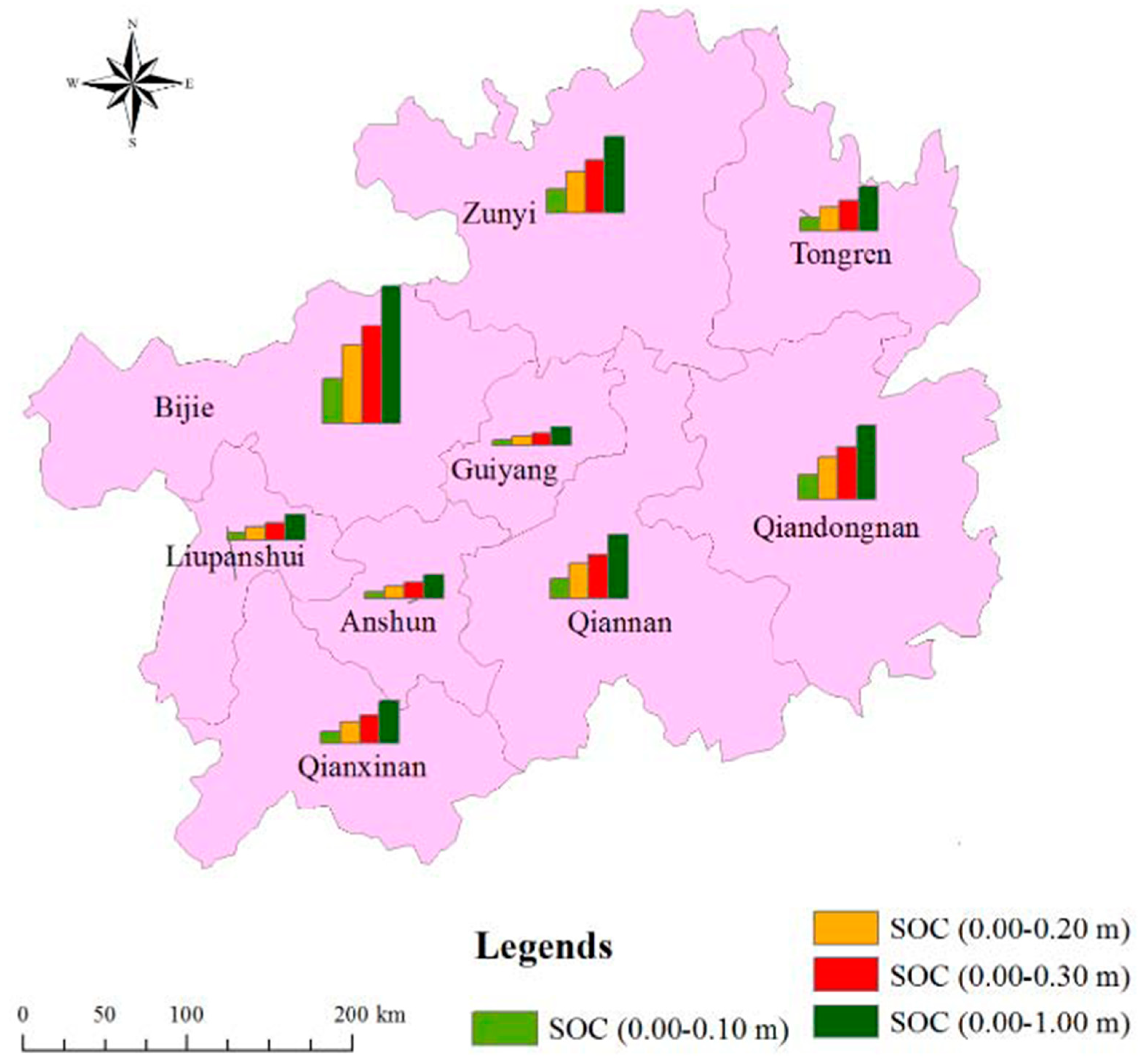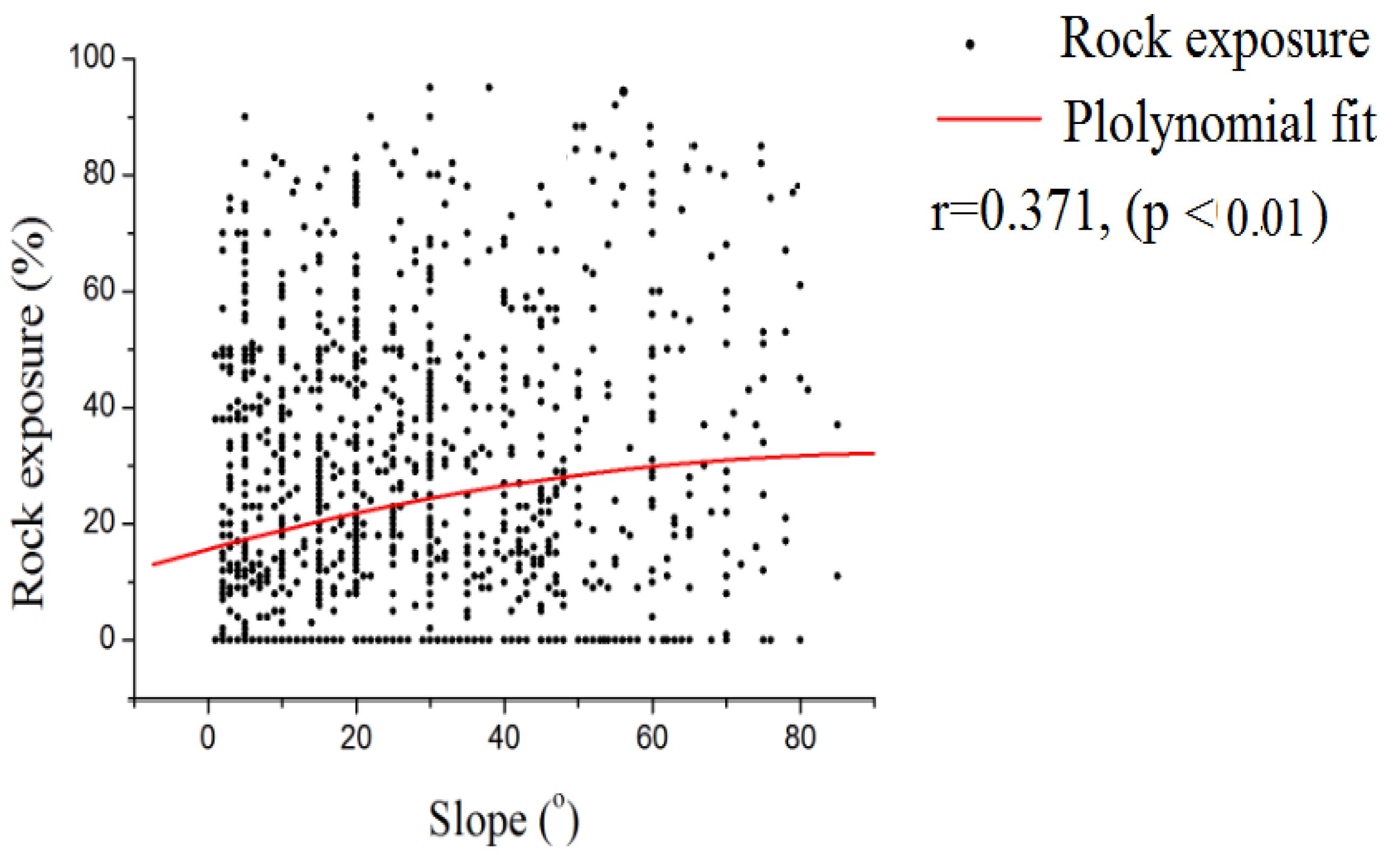Discrepancies in Karst Soil Organic Carbon in Southwest China for Different Land Use Patterns: A Case Study of Guizhou Province
Abstract
:1. Introduction
2. Materials and Methods
2.1. Study Region
2.2. Field Sampling
2.3. Calculation Methods and Statistical Analysis
3. Results
3.1. Profile Characteristics of the SOC Concentrations for Different Land Uses
3.2. Effects of Land Use on Soil Bulk Density
3.3. Profile Characteristics of the SOC Densities for Different Land Uses
3.4. Storage of SOC in Guizhou Province
4. Discussion
4.1. Factors Affecting the SOC Concentration
4.2. Factors Affecting SOC Density and Storage in Guizhou Province
5. Conclusions
Author Contributions
Funding
Conflicts of Interest
References
- Veum, K.S.; Goyne, K.W.; Holan, S.H.; Motavalli, P.P. Assessment of soil organic carbon and total nitrogen under conservation management practices in the Central Claypan Region, Missouri, USA. Geoderma 2011, 167–168, 188–196. [Google Scholar] [CrossRef]
- Zhang, L.H.; Xie, Z.K.; Zhao, R.F.; Wang, Y.J. The impact of land use change on soil organic carbon and labile organic carbon stocks in the Longzhong region of Loess Plateau. J. Arid Land 2012, 4, 241–250. [Google Scholar] [CrossRef]
- Wang, Q.K.; Wang, S.L.; He, T.X.; Liu, L.; Wu, J.B. Response of organic carbon mineralization and microbial community to leaf litter and nutrient additions in subtropical forest soils. Soil Biol. Biochem. 2014, 71, 13–20. [Google Scholar] [CrossRef]
- Yang, Y.H.; Chen, Y.N.; Li, W.H.; Chen, Y.P. Distribution of soil organic carbon under different vegetation zones in the Ili River Valley, Xinjiang. J. Geogr. Sci. 2010, 20, 729–740. [Google Scholar] [CrossRef]
- Wiaux, F.; Vanclooster, M.; Cornelis, J.T.; Oost, K.V. Factors controlling soil organic carbon persistence along an eroding hill slope on the loess belt. Soil Biol. Biochem. 2014, 77, 187–196. [Google Scholar] [CrossRef]
- Wang, X.G.; Zhu, B.; Hua, K.K.; Luo, Y.; Zhang, J.; Zhang, A.B. Assessment of soil organic carbon stock in the upper Yangtze River basin. J. Mt. Sci. 2013, 10, 866–872. [Google Scholar] [CrossRef]
- Scharlemann, J.P.W.; Tanner, E.V.; Hiederer, R.; Kapos, V. Global soil carbon: Understanding and managing the largest terrestrial carbon pool. Carbon Manag. 2014, 5, 81–91. [Google Scholar] [CrossRef]
- Wang, Q.Y.; Wang, Y.Y.; Wang, Q.C.; Liu, J.S. Impacts of 9 years of a new conservational agricultural management on soil organic carbon fractions. Soil Tillage Res. 2014, 143, 1–6. [Google Scholar] [CrossRef]
- Zhang, J.; Wang, X.J.; Wang, J.P.; Wang, W.X. Carbon and nitrogen contents in typical plants and soil profiles in Yanqi Basin of Northwest China. J. Integr. Agric. 2014, 13, 648–656. [Google Scholar] [CrossRef]
- Pan, G.X. Study on carbon reservoir in soils of China. Bull. Sci. Technol. 1999, 15, 330–332. [Google Scholar]
- Wang, S.Q.; Liu, J.Y.; Yu, G.R. Error analysis of estimating terrestrial soil organic carbon storage in China. Chin. J. Appl. Ecol. 2003, 14, 797–802. (In Chinese) [Google Scholar]
- Wang, S.Q.; Zhou, C.H.; Li, K.R.; Zhu, S.L.; Huang, F.H. Estimation of soil organic carbon reservoir in China. J. Geogr. Sci. 2001, 11, 3–13. [Google Scholar]
- Xie, X.L.; Sun, B.; Zhou, H.Z.; Li, Z.P.; Li, A.B. Organic carbon density and storage in soils of china and spatial analysis. Acta Pedol. Sin. 2004, 41, 35–43. (In Chinese) [Google Scholar]
- Wu, H.B.; Guo, Z.T.; Peng, C. Distribution and storage of soil organic carbon in China. Glob. Biogeochem. Cycles 2003, 17, 1–6. [Google Scholar] [CrossRef]
- Wang, S.Q.; Zhou, C.H.; Li, K.R.; Zhu, S.L.; Huang, F.H. Analysis on spatial distribution characteristics of soil organic carbon reservoir in China. Acta Geogr. Sin. 2000, 55, 533–544. (In Chinese) [Google Scholar]
- Wang, S.Q.; Zhou, C.H. Estimating soil carbon reservoir of terrestrial ecosystem in China. Geogr. Res. 1999, 18, 349–356. (In Chinese) [Google Scholar]
- Zech, M.; Hörold, C.; Leiber-Sauheitl, K.; Kühnel, A.; Hemp, A.; Zech, W. Buried black soils on the slopes of Mt. Kilimanjaro as a regional carbon storage hotspot. Catena 2014, 112, 125–130. [Google Scholar] [CrossRef]
- Ying, B.; Xiao, S.Z.; Xiong, K.N.; Cheng, Q.W.; Luo, J.S. Comparative studies of the distribution characteristics of rocky desertification and land use/land cover classes in typical areas of Guizhou province, China. Environ. Earth Sci. 2012, 71, 631–645. [Google Scholar] [CrossRef]
- Yu, D.S.; Zhang, Z.Q.; Yang, H.; Shi, X.Z.; Tan, M.Z.; Sun, W.X.; Wang, H.J. Effect of soil sampling density on detected spatial variability of soil organic carbon in a red soil region of China. Pedosphere 2011, 21, 207–213. [Google Scholar] [CrossRef]
- Liu, Z.T.; Liu, C.Q.; Lang, Y.C.; Hu, D. Dissolved organic carbon and its carbon isotope compositions in hill slope soils of the karst area of southwest China: Implications for carbon dynamics in limestone soil. Geochem. J. 2014, 48, 277–290. [Google Scholar] [CrossRef]
- Rodeghiero, M.; Cescatti, A. Spatial variability and optimal sampling strategy of soil respiration. For. Ecol. Manag. 2008, 255, 106–112. [Google Scholar] [CrossRef]
- Li, Z.P.; Han, F.X.; Su, Y.; Zhang, T.L.; Sun, B.; Monts, D.L.; Plodinec, M.J. Assessment of soil organic and carbonate carbon storage in China. Geoderma 2007, 138, 119–126. [Google Scholar] [CrossRef]
- Zhang, J.Y.; Dai, M.H.; Wang, L.C.; Zeng, C.F.; Su, W.C. The challenge and future of rocky desertification control in karst areas in southwest China. Solid Earth Discuss. 2015, 7, 3271–3292. [Google Scholar] [CrossRef]
- Wang, D.J.; Shen, Y.X.; Huang, J. Epilithic organic matter and nutrient contents in three different karst. Mt. Res. 2015, 33, 16–24. [Google Scholar]
- Ni, J.P.; Yuan, D.X.; Xie, D.T. Estimation of soil organic carbon storage and the characteristic of carbon spatial distributions in karst area, Chongqing, China. Acta Ecol. Sin. 2009, 29, 6292–6301. (In Chinese) [Google Scholar]
- Yu, D.S.; Shi, X.Z.; Wang, H.J.; Sun, W.X.; Chen, J.M.; Liu, Q.H.; Zhao, Y.C. Regional patterns of soil organic carbon stocks in China. J. Environ. Manag. 2007, 85, 680–689. [Google Scholar] [CrossRef]
- Huang, X.F.; Zhou, Y.C.; Zhang, Z.M. Carbon Sequestration Anticipation Response to Land Use Change in a Mountainous Karst Basin in China. J. Environ. Manag. 2018, 228, 40–46. [Google Scholar] [CrossRef]
- Liu, M.Y.; Chang, Q.R.; Qi, Y.B.; Liu, J.; Chen, T. Aggregation and soil organic carbon fractions under different land uses on the tableland of the Loess Plateau of China. Catena 2014, 115, 19–28. [Google Scholar] [CrossRef]
- Six, J.; Bossuyt, H.; Degryze, S.; Denef, K. A history of research on the link between (micro) aggregates, soil biota, and soil organic matter dynamics. Soil Tillage Res. 2004, 79, 7–31. [Google Scholar] [CrossRef]
- Six, J.; Conant, R.T.; Paul, E.A.; Paustian, K. Stabilization mechanisms of soil organic matter: Implications for C-saturation of soils. Plant Soil 2002, 241, 155–176. [Google Scholar] [CrossRef]
- Hoffmann, U.; Hoffmann, T.; Jurasinski, G.; Glatzel, S.; Kuhn, N.J. Assessing the spatial variability of soil organic carbon stocks in an alpine setting (Grindelwald, Swiss Alps). Geoderma 2014, 232, 270–283. [Google Scholar] [CrossRef]
- Su, X.L. Karst rocky desertification and ecology rehabilitation in Guizhou Province. Earth Environ. 2005, 33, 20–28. (In Chinese) [Google Scholar]
- Zhang, Z.M.; Zhou, Y.C.; Wang, S.J.; Wang, S.J.; Huang, X.F. Spatial Distribution of Stony Desertification and Key Influencing Factors on Different Sampling Scales in Small Karst Watersheds. Int. J. Environ. Res. Public Health 2018, 15, 743. [Google Scholar] [CrossRef] [PubMed]
- Nelson, D.W.; Sommers, L.E. Total carbon, organic carbon, and organic matter. In Methods of Soil Analysis, Agronomy, Part 2, 2nd ed.; Page, A.L., Miller, R.H., Keeney, D.R., Eds.; ASA and SSSA: Madison, WI, USA, 1982; pp. 539–577. [Google Scholar]
- Shete, M.; Rutten, M.; Schoneveld, G.C.; Zewde, E. Land-use changes by large-scale plantations and its effects on soil organic carbon, micronutrients and bulk density: Empirical evidence from ethiopia. Agric. Hum. Values 2015, 32, 1–16. [Google Scholar]
- Wei, J.B.; Xiao, D.N.; Zhang, X.Y.; Li, X.Z.; Li, X.Y. Spatial variability of soil organic carbon in relation to environmental factors of a typical small watershed in the black soil region, Northeast China. Environ. Monit. Assess. 2006, 121, 597–613. [Google Scholar]
- Chen, S.Z.; Zhou, Z.F.; Yan, L.H.; Li, B. Quantitative Evaluation of Ecosystem Health in a Karst Area of South China. Sustainability 2016, 8, 975. [Google Scholar] [CrossRef]
- Lin, J.; Sun, Y.; Lammers, P.S. Evaluating model-based relationship of cone index, soil water content and bulk density using dual-sensor penetrometer data. Soil Tillage Res. 2014, 138, 9–16. [Google Scholar] [CrossRef]
- Pan, F.J.; Liang, Y.M.; Wang, K.; Zhang, W. Responses of Fine Root Functional Traits to Soil Nutrient Limitations in a Karst Ecosystem of Southwest China. Forests 2018, 9, 743. [Google Scholar] [CrossRef]
- Song, L.H. Progress and trend of karst geomorphology study. Prog. Geogr. 2000, 19, 193–202. (In Chinese) [Google Scholar]





| Districts | Unit | NRSD | LRSD | RDLD | RDMD | RDSD | RDESD | Non-Karst Region |
|---|---|---|---|---|---|---|---|---|
| Guiyang | area (km2) | 2761.11 | 2192.05 | 1307.25 | 487.54 | 80.01 | 2.29 | 1203.64 |
| Percentage (%) | 34.37 | 27.29 | 16.27 | 6.07 | 1.00 | 0.03 | 14.98 | |
| Qiannan | area (km2) | 662.08 | 7015.02 | 4576.18 | 2098.91 | 847.92 | 194.48 | 4838.81 |
| Percentage (%) | 3.27 | 34.67 | 22.62 | 10.37 | 4.19 | 0.96 | 23.91 | |
| Anshun | area (km2) | 2475.85 | 1182.27 | 1243.53 | 954.51 | 601.06 | 170.61 | 2639.57 |
| Percentage (%) | 26.72 | 12.76 | 13.42 | 10.30 | 6.49 | 1.84 | 28.48 | |
| Qianxinan | area (km2) | 2985.97 | 2114.12 | 2111.54 | 1757.17 | 870.56 | 290.15 | 6674.49 |
| Percentage (%) | 17.77 | 12.58 | 12.57 | 10.46 | 5.18 | 1.73 | 39.72 | |
| Liupanshui | area (km2) | 1468.00 | 1529.49 | 1574.20 | 921.71 | 635.18 | 134.51 | 3650.71 |
| Percentage (%) | 14.81 | 15.43 | 15.88 | 9.30 | 6.41 | 1.36 | 36.82 | |
| Bijie | area (km2) | 6086.72 | 6597.99 | 4577.18 | 2066.50 | 312.94 | 51.76 | 7160.01 |
| Percentage (%) | 22.67 | 24.57 | 17.05 | 7.70 | 1.17 | 0.19 | 26.66 | |
| Zunyi | area (km2) | 8452.08 | 7109.84 | 3222.53 | 1275.83 | 173.81 | 1.59 | 10526.05 |
| Percentage (%) | 27.48 | 23.11 | 10.48 | 4.15 | 0.57 | 0.01 | 34.22 | |
| Qiandongnan | area (km2) | 2906.35 | 2345.66 | 1253.23 | 493.43 | 36.94 | 0.00 | 23301.39 |
| Percentage (%) | 9.58 | 7.73 | 4.13 | 1.63 | 0.12 | 0.00 | 76.81 | |
| Tongren | area (km2) | 3701.88 | 3940.14 | 2290.12 | 813.35 | 156.99 | 11.85 | 7088.67 |
| Percentage (%) | 20.56 | 21.89 | 12.72 | 4.52 | 0.87 | 0.07 | 39.37 |
| Soil Layers | Cropland | Garden Land | Grassland | Forest Land | Uncultivated Land |
|---|---|---|---|---|---|
| 0.00–0.05 m | 23.92 ± 0.22Ja N = 1678 | 23.69 ± 1.32Ea N = 66 | 29.91 ± 1.28Gb N = 142 | 41.22 ± 0.86Hd N = 563 | 38.88 ± 1.00Hc N = 405 |
| 0.05–0.10 m | 21.47 ± 0.20Ia N = 1678 | 20.49 ± 1.25Da N = 66 | 24.93 ± 1.08Fb N = 142 | 34.89 ± 0.75Gd N = 563 | 32.44 ± 0.89Gc N = 405 |
| 0.10–0.15 m | 19.01 ± 0.20Ha N = 1674 | 17.47 ± 1.31Ca N = 64 | 21.47 ± 1.03Eb N = 142 | 30.07 ± 0.75Fd N = 556 | 27.35 ± 0.78Fc N = 395 |
| 0.15–0.20 m | 16.01 ± 0.20Ga N = 1662 | 15.23 ± 1.24Ca N = 63 | 18.79 ± 1.00Db N = 118 | 25.57 ± 0.73Ed N = 526 | 23.76 ± 0.73Ec N = 343 |
| 0.20–0.30 m | 12.51 ± 0.19Fa N = 1592 | 12.18 ± 1.10Ba N = 61 | 16.04 ± 0.99Cb N = 91 | 19.69 ± 0.62Dc N = 488 | 19.64 ± 0.74Dc N = 287 |
| 0.30–0.40 m | 9.69 ± 0.16Ea N = 1552 | 9.55 ± 0.82Aba N = 52 | 12.76 ± 0.88Bb N = 64 | 14.30 ± 0.58Cbc N = 400 | 15.57 ± 0.75Cc N = 231 |
| 0.40–0.50 m | 8.25 ± 0.15Da N = 1381 | 8.08 ± 0.64Aa N = 31 | 9.76 ± 0.65aABb N = 34 | 10.99 ± 0.61Bb N = 336 | 12.36 ± 0.74Bc N = 184 |
| 0.50–0.60 m | 7.22 ± 0.15Ca N = 1209 | 7.77 ± 0.65Aab N = 27 | 8.45 ± 0.67Aab N = 19 | 9.21 ± 0.64Abb N = 267 | 9.01 ± 0.54Abb N = 156 |
| 0.60–0.70 m | 6.68 ± 0.15Ca N = 1081 | 6.96 ± 0.73Aab N = 16 | 8.09 ± 0.70Aab N = 14 | 7.20 ± 0.58Aab N = 206 | 7.56 ± 0.51Ab N = 143 |
| 0.70–0.80 m | 6.03 ± 0.15Ba N = 983 | 8.03 ± 1.58Aab N = 13 | 6.67 ± 0.70Aab N = 14 | 6.60 ± 0.53Aab N = 192 | 7.09 ± 0.53Ab N = 132 |
| 0.80–0.90 m | 5.54 ± 0.15Aba N = 871 | 6.00 ± 0.58Aa N = 12 | 6.76 ± 0.79Aa N = 13 | 6.34 ± 0.53Aa N = 185 | 5.96 ± 0.51Aa N = 120 |
| 0.90–1.00 m | 5.17 ± 0.15Aa N = 603 | 5.78 ± 0.61Aa N = 11 | 6.37 ± 0.78Aa N = 12 | 5.60 ± 0.46Aa N = 180 | 5.42 ± 0.42Aa N = 115 |
| Soil Layers | Cropland | Garden Land | Grassland | Forestland | Uncultivated Land |
|---|---|---|---|---|---|
| 0.00–0.05 m | 1.20 ± 0.01Ac | 1.20 ± 0.02Ac | 1.19 ± 0.02Ac | 1.10 ± 0.01Aa | 1.14 ± 0.01Ab |
| 0.05–0.10 m | 1.25 ± 0.01Bc | 1.26 ± 0.02Ac | 1.24 ± 0.01Bbc | 1.14 ± 0.01Ba | 1.21 ± 0.01Bb |
| 0.10–0.15 m | 1.33 ± 0.01Cc | 1.33 ± 0.03Bc | 1.33 ± 0.02Cc | 1.17 ± 0.01Ca | 1.25 ± 0.01Cb |
| 0.15–0.20 m | 1.40 ± 0.01Ec | 1.36 ± 0.02BCc | 1.33 ± 0.02Cbc | 1.20 ± 0.01Da | 1.29 ± 0.01Db |
| 0.20–0.30 m | 1.43 ± 0.01Fc | 1.35 ± 0.03BCb | 1.35 ± 0.02Cb | 1.24 ± 0.01DEa | 1.33 ± 0.01Db |
| 0.30–0.40 m | 1.41 ± 0.01EFb | 1.35 ± 0.03BCb | 1.38 ± 0.02Cb | 1.29 ± 0.01Ea | 1.38 ± 0.02Eb |
| 0.40–0.50 m | 1.41 ± 0.01EFb | 1.36 ± 0.03BCab | 1.35 ± 0.02Cab | 1.31 ± 0.01Ea | 1.38 ± 0.02EFb |
| 0.50–0.60 m | 1.42 ± 0.02Fb | 1.39 ± 0.03BCab | 1.38 ± 0.02Cab | 1.33 ± 0.02Ea | 1.42 ± 0.02Fab |
| 0.60–0.70 m | 1.39 ± 0.01DEb | 1.38 ± 0.03BCab | 1.35 ± 0.03Cab | 1.32 ± 0.02Ea | 1.45 ± 0.02Fc |
| 0.70–0.80 m | 1.37 ± 0.01Db | 1.42 ± 0.04Cbc | 1.36 ± 0.03Cab | 1.30 ± 0.02Ea | 1.45 ± 0.03Fc |
| 0.80–0.90 m | 1.36 ± 0.01Db | 1.46 ± 0.05Cc | 1.31 ± 0.05BCab | 1.30 ± 0.02Ea | 1.46 ± 0.04Fc |
| 0.90–1.00 m | 1.34 ± 0.01CDb | 1.38 ± 0.03 BCb | 1.32 ± 0.03BCab | 1.28 ± 0.02Ea | 1.38 ± 0.03DEb |
| Depth | Cropland | Garden land | Grassland | Forest Land | Uncultivated Land |
|---|---|---|---|---|---|
| 0.00–0.10 m | 2.32 ± 0.02AB | 2.06 ± 0.09A | 2.17 ± 0.09A | 2.67 ± 0.06C | 2.41 ± 0.07B |
| 0.00–0.20 m | 4.27 ± 0.04B | 3.71 ± 0.18A | 3.85 ± 0.17A | 4.52 ± 0.11C | 4.17 ± 0.12AB |
| 0.00–0.30 m | 5.63 ± 0.06B | 4.87 ± 0.24A | 5.08 ± 0.23A | 5.62 ± 0.14B | 5.25 ± 0.17A |
| 0.00–0.40 m | 6.61 ± 0.07B | 5.81 ± 0.30A | 5.95 ± 0.26A | 6.23 ± 0.16A | 5.94 ± 0.20A |
| 0.00–0.50 m | 7.37 ± 0.09B | 6.59 ± 0.35A | 6.54 ± 0.30A | 6.61 ± 0.17AB | 6.34 ± 0.22A |
| 0.00–0.60 m | 7.99 ± 0.10B | 7.32 ± 0.42AB | 6.98 ± 0.33A | 6.85 ± 0.18A | 6.58 ± 0.23A |
| 0.00–0.70 m | 8.51 ± 0.10B | 7.91 ± 0.48B | 7.34 ± 0.36AB | 7.01 ± 0.19AB | 6.73 ± 0.24A |
| 0.00–0.80 m | 8.94 ± 0.11B | 8.45 ± 0.57B | 7.63 ± 0.38AB | 7.14 ± 0.19A | 6.83 ± 0.24A |
| 0.00–0.90 m | 9.29 ± 0.12C | 8.79 ± 0.61B | 7.86 ± 0.40B | 7.25 ± 0.20AB | 6.89 ± 0.24A |
| 0.00–1.00 m | 9.58 ± 0.13C | 9.07 ± 0.64BC | 8.07 ± 0.42B | 7.35 ± 0.20AB | 6.94 ± 0.24A |
© 2019 by the authors. Licensee MDPI, Basel, Switzerland. This article is an open access article distributed under the terms and conditions of the Creative Commons Attribution (CC BY) license (http://creativecommons.org/licenses/by/4.0/).
Share and Cite
Zhang, Z.; Huang, X.; Zhou, Y.; Zhang, J.; Zhang, X. Discrepancies in Karst Soil Organic Carbon in Southwest China for Different Land Use Patterns: A Case Study of Guizhou Province. Int. J. Environ. Res. Public Health 2019, 16, 4199. https://doi.org/10.3390/ijerph16214199
Zhang Z, Huang X, Zhou Y, Zhang J, Zhang X. Discrepancies in Karst Soil Organic Carbon in Southwest China for Different Land Use Patterns: A Case Study of Guizhou Province. International Journal of Environmental Research and Public Health. 2019; 16(21):4199. https://doi.org/10.3390/ijerph16214199
Chicago/Turabian StyleZhang, Zhenming, Xianfei Huang, Yunchao Zhou, Jiachun Zhang, and Xubo Zhang. 2019. "Discrepancies in Karst Soil Organic Carbon in Southwest China for Different Land Use Patterns: A Case Study of Guizhou Province" International Journal of Environmental Research and Public Health 16, no. 21: 4199. https://doi.org/10.3390/ijerph16214199





